| Back Number | No.03 2004/11/24 | |||
| News | The 2nd Meeting of Commissioners General of Section Held |  |
||
| Pavilions : Japan Pavilion Nagakute | ||||
| Interview | Catherine de Silguy (France) Agriculturist; Engineer of the French Agency for Environment and Energy Management (ADEME) |
|||
| Column | Biomass | |||
![]()
|
|
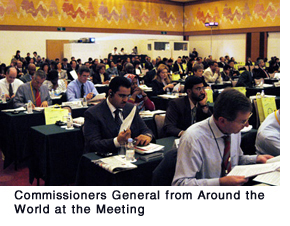 Some country representatives were seen enthusiastically introducing and promoting the content of their exhibitions in front of panels at the display booths set up at the hotel. Official participants also visited the Expo site on the second day.
Some country representatives were seen enthusiastically introducing and promoting the content of their exhibitions in front of panels at the display booths set up at the hotel. Official participants also visited the Expo site on the second day.Ambassador Taizo Watanabe, Commissioner General of the 2005 World Exposition Aichi, Japan said, at a press conference after the closing of the meeting, "It was impressive to see the willingness of both the Japan Association for the 2005 World Exposition and official participants to follow the rules, respect each other's position and cooperate through the discussions held over the two days." Wu Jianmin, President of the International Exhibitions Bureau (BIE), spoke about the need for world expositions, saying that as a BIE ideal, world expositions not only create peace but also promote dialogue among civilizations, and it is an important ingredient for deepening mutual understanding. On November 10, Wu Jianmin, President of BIE, and Vincente Gonzalez Loscertales, Secretary-General, made a courtesy visit to Minister of Economy, Trade and Industry Shoichi Nakagawa, Deputy Chief Cabinet Secretary Seiken Sugiura, and Senior Vice Minister for Foreign Affairs Syuzen Tanigawa to report on the 2nd meeting. *Aichi International Campaign for Hometown Interchange and Hospitality (Aichi Hospitality): This is a project to widely promote international exchange, especially grass-roots exchange, by positioning the cities, towns and villages of Aichi Prefecture as "home cities" and "home towns" for participating countries, and help boost the mood of EXPO 2005. |
![]()
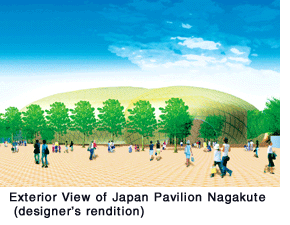 The Government of Japan will be hosting three pavilions at EXPO 2005 Aichi,
Japan. They are the Japan Pavilion Nagakute, Japan Pavilion Seto, and
Japan Pavilion on the Web (http://www.nippon-kan.jp).
The key message of the Japanese government's exhibition program is, "Rekindle
the Relationship between Humankind and Nature". The Japan pavilions
at EXPO 2005 Aichi, Japan will propose a new prosperity in which the people
of the world and nature can coexist. In this issue we will introduce Japan
Pavilion Nagakute from among the three pavilions to be exhibited by the
Government of Japan.
The Government of Japan will be hosting three pavilions at EXPO 2005 Aichi,
Japan. They are the Japan Pavilion Nagakute, Japan Pavilion Seto, and
Japan Pavilion on the Web (http://www.nippon-kan.jp).
The key message of the Japanese government's exhibition program is, "Rekindle
the Relationship between Humankind and Nature". The Japan pavilions
at EXPO 2005 Aichi, Japan will propose a new prosperity in which the people
of the world and nature can coexist. In this issue we will introduce Japan
Pavilion Nagakute from among the three pavilions to be exhibited by the
Government of Japan. |
| A mysterious-looking two-story wooden structure,
covered like a cocoon with nearly 30,000 bamboos, will be appearing in
the Nagakute Area of EXPO 2005 Aichi, Japan. It is the Japan Pavilion
Nagakute hosted by the Government of Japan. The theme of this pavilion
is, "Creating 21st Century Prosperity through Japan's Experience
- Let's Grow Closer to Nature Again." Visitors will be able to experience this theme through three zones at the pavilion. In Zone 1, people will watch beautiful footage from various locations around the world and become aware of the hidden signs of crisis - such as global warming and desertification - that face humankind. At Zone 2, visitors will travel on a moving walkway and see exhibits that express Japan's experiences over the past 60 years in how the Japanese people have been linking daily life with nature. Zone 3 will present concrete proposals through three areas on three relationships that will be of importance from now: "nature-to-life," "people-to-technology," and "technology-to-nature." Visitors will be met by a forest environment created through the full utilization of light, sound, scent and images that will enable them to experience the spiritual comfort of being connected with nature. |
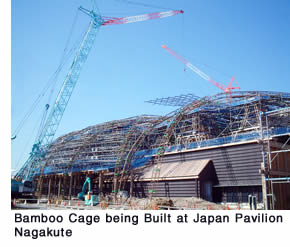 Furthermore, the world's first 360-degree all-sky video system will be
making an appearance at this pavilion in the form of a globe with a diameter
of 12.8 meters (1/1,000,000 scale model of the Earth). This is the Earth
Vision, a visual expression of the life force and splendor of our planet.
Within the Earth Vision, visitors will be able to experience a sense of
becoming one with our planet by feeling the Earth's innate vital forces.
Furthermore, the world's first 360-degree all-sky video system will be
making an appearance at this pavilion in the form of a globe with a diameter
of 12.8 meters (1/1,000,000 scale model of the Earth). This is the Earth
Vision, a visual expression of the life force and splendor of our planet.
Within the Earth Vision, visitors will be able to experience a sense of
becoming one with our planet by feeling the Earth's innate vital forces.It should also be noted that the construction of the Japan Pavilion Nagakute itself expresses the pavilion's theme. The concept of covering the entire building with a bamboo cage was derived from the ancient Japanese wisdom of weaving bamboo together to create a lattice for providing shade. This bamboo covering will prevent direct sunlight from hitting the building and create an environment that is similar to being under the breezy shade of trees in a forest. This structure will lower the interior room temperature and help conserve the electricity needed for air conditioning. |
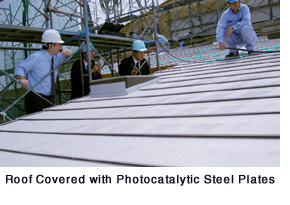 Furthermore, a system comprised of water streaming down photocatalytic
steel plates that line the roof has been adopted. The latent heat of evaporation
through this system will also help lower the interior temperature. This
system combines an old Japanese custom - seeking cool air by sprinkling
water in the road and yard around one's home - with the Japanese discovery
of the super-hydrophilic phenomenon that photocatalysts bring about.
Furthermore, a system comprised of water streaming down photocatalytic
steel plates that line the roof has been adopted. The latent heat of evaporation
through this system will also help lower the interior temperature. This
system combines an old Japanese custom - seeking cool air by sprinkling
water in the road and yard around one's home - with the Japanese discovery
of the super-hydrophilic phenomenon that photocatalysts bring about.Photocatalytic technology utilizes the oxidation that occurs when light hits titanium oxide for decomposing grime and germs. It has various applications including air purification, water purification and antibacterial and antifouling measures. However, when the steel plates coated with titanium oxide at Japan Pavilion Nagakute are hit by light, the surface tension of water is lowered and this prevents water from becoming spherical in shape. This property of the photocatalyst is utilized to forms a thin layer of water over the roof. In other words, water evaporates faster on photocatalytic steel plates through exposure to sunlight as compared with other mediums, and the temperature on the other side of the roof is lowered as the evaporating water robs the surrounding area of heat. The electrical power for the operation of this pavilion will be provided, in its entirety, through a new power system that utilizes generation means such as solar energy and biomass energy. The pavilion is also filled with other ingenuity that lowers the burden placed on the environment. It includes the use, in its construction, of lumber from thinning, roof tiling of bamboo, and wall surfaces of biodegradable plastic. The whole of Japan Pavilion Nagakute is a testing ground for new technology and materials. It is an actively experimental pavilion. |
![]()
![]()
 |
|
 The phrase, “Nature’s Wisdom” is a bit intriguing for
the French when they hear it for the first time. It contains an Asiatic
ring as well as a Buddhist air, and it makes people wonder and think about
what it means. But I think it makes for a very interesting concept coupled
with the sub themes, “Art of Life” and “Development
for Eco-Communities.”
The phrase, “Nature’s Wisdom” is a bit intriguing for
the French when they hear it for the first time. It contains an Asiatic
ring as well as a Buddhist air, and it makes people wonder and think about
what it means. But I think it makes for a very interesting concept coupled
with the sub themes, “Art of Life” and “Development
for Eco-Communities.”There are two aspects to technology: high technology and “old technology,” rooted in humankind’s wise, old traditions. I am very interested in the mixture of the roles of these two types of technologies, especially as it relates to issues in less-developed nations. I have worked with small NGOs in less-developed nations. I found that while the people of such nations possess the wisdom of how to commune very wisely with nature, it is at times difficult for them to think about saving resources, such as wood fuel, for the future.This is because, in their poverty, many can only deal with what is in front of them: how to eat today or tomorrow.Learned individuals, of course, are aware of such issues. I find it both very interesting and gratifying that among the more than 100 countries that will be participating in EXPO 2005, many are from developing countries. I think it will result in the birth of mutual respect among participating countries as well as increased awareness of the importance of “old technology,” which is rooted in tradition. I feel that this Exposition will become a stage on which we will hear the symphonies of new and old technologies as well as different cultures. I think that it is also very meaningful that EXPO 2005 is being held in Japan, which like Europe, is a high-tech society that is very sensitive to nature. |
|
![]()
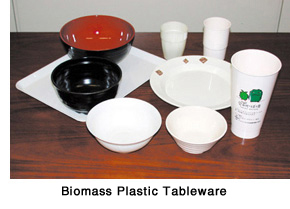 You have probably heard of the term biomass; it refers to renewable organic
resources derived from plants and animals. Visitors to EXPO 2005 Aichi,
Japan will be encountering human ingenuity in the practical use of biomass.
You have probably heard of the term biomass; it refers to renewable organic
resources derived from plants and animals. Visitors to EXPO 2005 Aichi,
Japan will be encountering human ingenuity in the practical use of biomass.You enter a restaurant and order. The plate that the food is served on, and the glass that your drink is in, are both made of biomass plastic (biodegradable resin). The raw materials for this plastic are a corn-based resin, clay and scallop-shell powder. Unlike petroleum-based plastic, once disposed, these plates and glasses will be broken down into water and carbon dioxide by microorganisms living in soil. At EXPO 2005, they will be converted into compost, together with raw garbage from the venue, and reused as fertilizer. In other words, they are environmentally-friendly tableware. You enter Japan Pavilion Nagakute and find yourself in a brightly lit interior. The raw garbage from the restaurant that you were just at is being utilized to fuel a portion of the electrical power of this pavilion. The electricity is generated by fuel cells that are powered through gas produced by the raw garbage, etc. from the venue. Approximately 5 tons of the garbage that is generated every day at the EXPO venue will be used to produce electricity. A long line of solar panels that extend for about 200 meters can be found outside of the EXPO venue close to the West Gate. This new compound energy system, which combines solar power, electricity generated by use of raw garbage and other new power generation methods, was realized by bringing together cutting-edge technology that is in the spotlight today. Japan Pavilion Nagakute will be completely powered through this new system. You discover, also close to the West Gate, what are called "bio toilets." These lavatories utilize the action of microorganisms to turn wastewater into odorless clear water that can be reused. Wastewater is first stored in a wastewater pit. It then moves on to a processing chamber within a large tank. Microorganisms, which have been propagated in large quantities here, breakdown the organic matter in the wastewater and eliminate nitrogen and other odor-producing elements contained therein. Next, a membrane filter removes colitis germs and impurities, and finally, the water is sterilized using ozone gas. The bio-treatment of wastewater is completed in about two days after which the purified water can be reused for purposes such as flushing the toilet. Organizers are expecting to conserve about 10 million tons of water during the 6-month duration of the EXPO. Why not take time during your visit to discover the many types of advanced technology that will be implemented throughout the EXPO 2005 Aichi, Japan venue and will allow us to live in harmony with nature? |
|
| EXPO 2005 AICHI, JAPAN Newsletter | |
| To read past issues:Back Number | |
| Editor/Publisher: Japan Association for
the 2005 World Exposition Head Office: 1533-1 Ibaragabasama, Nagakute-cho Aichi 480-1101 Japan Nagoya Office: Nagoya Daiya II Bldg 4F, 3-15-1 Meieki Nakamura-ku, Nagoya, Aichi 450-0002 Japan Tokyo Office: Iino Bldg 8F, 2-1-1 Uchisaiwai-cho Chiyoda-ku, Tokyo 100-0011 Japan |
 |

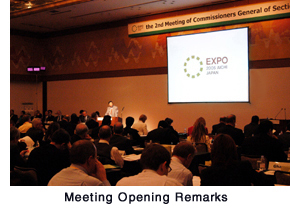 With only about four months left before the opening of EXPO 2005 Aichi,
Japan, the 2nd Meeting of Commissioners General of Section was held
for two days beginning on November 8 at a hotel in Nagoya City. This
is a meeting of representatives from participating countries and international
organizations for discussions in preparation for EXPO 2005. This was
the second meeting following the first held in November last year. About
330 people representing 100 countries and 4 international organizations
participated in the 2nd meeting.
With only about four months left before the opening of EXPO 2005 Aichi,
Japan, the 2nd Meeting of Commissioners General of Section was held
for two days beginning on November 8 at a hotel in Nagoya City. This
is a meeting of representatives from participating countries and international
organizations for discussions in preparation for EXPO 2005. This was
the second meeting following the first held in November last year. About
330 people representing 100 countries and 4 international organizations
participated in the 2nd meeting.